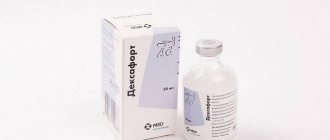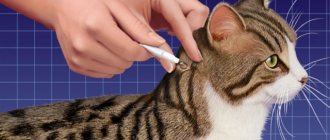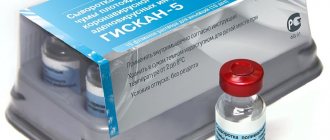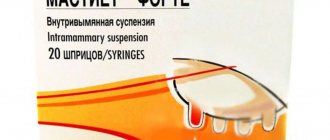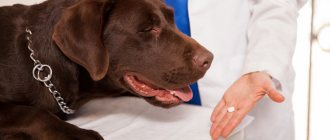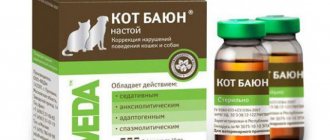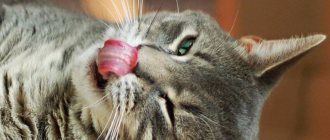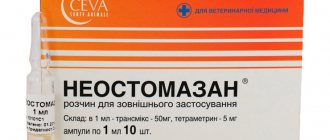Instructions
According to the instructions, per 10 kg of body weight of a four-legged pet, it is allowed to administer from 0.25 to 0.5 ml of a drug based on imidocarb dipropionate. The optimal amount of the drug is recommended by the veterinarian, taking into account the degree of infection and the well-being of the four-legged pet.
How and where to inject
When an antiprotozoal solution is administered, the animal may experience pain. For this reason, veterinarians prescribe for small dogs the use of no more than 2.5 ml of medication in one place, the next portion (if necessary) is administered to another area.
The injection is performed subcutaneously. Be sure to treat the skin with a disinfectant composition. The injection should only be given by a veterinarian,
Doing the procedure yourself may lead to side effects.
How often should injections be given?
Important! Be sure to follow safety precautions. You must not violate the instructions, administer a large dose or make repeated injections before the time specified by the doctor. The effect of imidocarb dipropionate lasts for more than a month, during the same period the optimal therapeutic concentration of the active component is in the blood
Repeated injection increases the maximum permissible rate, which leads to negative reactions
The effect of imidocarb dipropionate lasts for more than a month, during the same period the optimal therapeutic concentration of the active component is in the blood. Repeated injection increases the maximum permissible rate, which leads to negative reactions.
Features of use
Pirostop injections should be performed by a veterinarian in order to promptly provide first aid to the animal if complications develop. Performing manipulations on your own in the absence of appropriate experience can lead to side effects. Usually, before the procedure, a rapid test is performed, the results of which determine the need to use the solution.
It is important not to violate the instructions, not to exceed the recommended doses or to carry out repeated injections earlier than the deadlines established by the veterinarian. The main active ingredient remains in the body for up to two months, which corresponds to its optimal therapeutic concentration
With repeated administrations ahead of schedule, there is a risk of exceeding the maximum permissible concentrations and developing side effects.
The drug Pirostop description and composition
The international nonproprietary name of this domestic drug is imidocarb. The drug is available in the form of a solution for injections. The active component in it is imidocarb dipropionate
.
1 ml of the drug contains 120 mg of this substance. Auxiliary ingredients in the composition of “Pirostop” are:
- benzyl alcohol;
- polyvinylpyrrolidone;
- propionic acid.
The drug can be stored for no more than two years in a dark place.
, at a temperature not exceeding 25 degrees. However, it must be hermetically sealed, otherwise the medicine should be used within 24 hours. This product should be kept away from children and food.
The therapeutic concentration in the dog’s blood after the injection is achieved in about a day and is maintained for about 4–6 weeks. The active substance of the drug accumulates in the liver and kidneys of the animal. It leaves the body with urine.
In terms of the degree of action, such a medicine is classified as a moderately dangerous drug. According to GOST, it has a third hazard class. When using it, you must follow the recommended dosage
. If you neglect the rules of use, then there is a possibility of mutagenic, embryotoxic and irritating effects.
Medicine dosage
When treating cows, mules and horses, 2 ml of the product should be used for each hundredweight of the animal. To destroy pathogens of babesiosis, the dose can be increased to 4 ml for every 100 kg of weight
.
The therapeutic dose for sheep is 0.2 ml per 10 kg of their body weight, and the injections are performed once. When treating dogs, “Pirostop” is used at the rate of 0.25-0.5 ml for every 10 kg of weight
.
Main indications for use of the drug
The drug "Pirostop" is intended for prevention and treatment. Moreover, it is recommended to be used for the following ailments: babesiosis;
nuttalliosis; mixed invasion or anaplasmosis.
Drug studies
About 175 dogs of different breeds and sizes took part in Pirostop's research. The study was conducted at the Babushkinsky Veterinary Station, the MIG clinic and the Moscow animal shelter. Individuals infected with piroplasmosis were given one or two injections with a dose of 0.25-0.5 ml per kilogram of weight.
Research results indicate:
- It is optimal to give one injection at a rate of 0.5 ml per ten kilograms of the dog’s weight.
- Compared to the use of diminacene aceturate, Pirostop helped sick animals twice as quickly.
- The use of the medication entails minimal complications; it is also worth noting its simplicity and convenience.
Pharmacology
Pirostop represents the category of imidazoline drugs and has pronounced antiprotozoal properties.
After taking a single dosage, the drug is quickly absorbed into the blood, remaining in it for 4 to 6 weeks. The active component included in the drug in question accumulates in the kidneys and liver and is subsequently excreted from the body in the urine.
According to available information, Pirostop has a hazard class of 3
according to the level of influence on the body.
In other words, it can be considered a moderately dangerous medicine. If the recommended dosage is observed, it does not have a mutagenic, embryotoxic or local irritant effect
.
Pharmacological properties
The active ingredient of the drug belongs to the group of imidazolines and is highly effective against blood parasites: Babesia bovis, Babesia ovis, Babesia bigemina, Babesia colchica, Babesia equi, Babesia divergens, Babesia canis, Babesia caballi, Babesia gibsoni, Francaiella colchica, Theileria annulata, Theileria sergenti , Theileria mutans, Theileria orientalis, Theileria ovis, Theileria recondita, Theileria tarandirangiferis, Nuttallia equi, Anaplasma marginale, Anaplasma ovis, and Ehrlichia canis. The mechanism of the antiprotozoal action of imidocarb is associated with the suppression of the supply of inositol (vitamin-like substance), necessary for the life of the blood parasite, as well as with the disruption of the formation and use of polyamines by the blood parasite. After parenteral administration of the drug, the therapeutic concentration of imidocarb dipropionate in the blood is achieved within 18–24 hours and is maintained at a pyroplasmostatic level for 4–6 weeks. Imidocarb dipropionate accumulates mainly in the kidneys and liver and is excreted from the body mainly in the urine. In terms of the degree of impact on the body, Piro-Stop is classified as a moderately hazardous substance and in recommended doses does not have a locally irritating, embryotoxic or mutagenic effect.
Indications for use
The main purpose of Pirostop is to use it for preventive and therapeutic purposes against piroplasmosis and other diseases transmitted by ixodid ticks. Among them:
- Fransaiellosis.
- Theileriosis.
- Nuttalliosis.
- Anaplasmosis.
- Babesiosis.
- Ehrlichiosis.
- Mixed invasions.
As a prophylactic agent, Pirostop is indicated for animals in regions with high incidence rates. It is also recommended for dogs exposed to the threat of Ixodid ticks and, accordingly, infection with blood parasitic infections. This applies to cases of frequent walking in parks and forests, trips to hunt or to the country, as well as when moving out of town. Thus, the product can become an alternative to anti-parasitic drops or collars.
The frequency and dosage are selected depending on the purpose of use. To effectively prevent infection with ixodid ticks, a single use at the beginning of the spring-summer period or a day before the trip is sufficient.
Purpose
The drug in the form of injections is used for the prevention and treatment of blood parasitic infections, including:
- babesiosis (pyroplasmosis);
- anaplasmosis;
- ehrlichiosis;
- theileriosis;
- nuttalliosis;
- francaiellosis;
- mixed invasions.
Piroplasmosis is considered a dangerous disease. The parasite enters the animal’s blood after a tick bite, quickly spreads throughout the body through the bloodstream and begins its pathogenic effect: it destroys red blood cells, which leads to disruption of the functions of vital body systems. The owner may not notice the tick bite immediately and will only pay attention to the manifestations of the disease:
- elevated temperature (41 degrees and above);
- blood in urine;
- vomit.
The destruction of red blood cells - the cells responsible for transporting oxygen - leads to anemia and oxygen starvation. The load on the heart increases, the pet becomes lethargic and gets tired quickly. The disease can develop asymptomatically and kill the animal in a few months, which is why it is important to take preventive measures during the spring-summer season to avoid tick bites.
Important! Currently, in some regions of Russia there is a high incidence of piroplasmosis, so it is not recommended to neglect protection against a dangerous disease.
Infectious thrombocytopenia (anaplasmosis) is caused by pathogenic bacteria that enter the animal's body through a tick bite. Microorganisms attack platelets, which are responsible for blood clotting. At the initial stage of the disease, the dog's lymph nodes become enlarged, the mucous membranes turn yellow, breathing is difficult, and the temperature rises. The first stage lasts 3 weeks, but does not threaten the pet’s life. Without treatment, it turns into a subclinical form, when there are no external signs of the disease and the animal looks healthy, but destructive processes are occurring inside: pathogenic microorganisms have already penetrated the spleen and other organs.
In the third, chronic stage, the dog begins to bleed heavily. There are many bruises on the body, and there is blood in the urine. Due to a bleeding disorder, the animal can bleed to death and die from even minor wounds.
Theileria affects red blood cells as well as lymphocytes and leads to diseases of the liver, spleen, kidneys and bladder, lungs, and bone marrow. The disease may be marked by the following symptoms:
- jaundice;
- enlarged spleen;
- anemia;
- heat.
The rapid development of the disease can cause coma and death in a short period of time (in 50% of cases), but sometimes it is asymptomatic and ends without dangerous consequences.
Instructions for use
As stated above, Piro-stop for dogs is administered subcutaneously or intramuscularly. Therapeutic (medicinal) concentration in the animal’s blood is achieved only after 18-24 hours. The drug remains in the blood for one and a half to two months, which helps not only to destroy all blood parasites, but also to create a kind of “immunity”. If during this period the dog is bitten by a tick again, the imidocarb circulating in the blood will protect the animal. The active substance will remain in the kidneys and liver all this time.
Despite this long-term cumulation (accumulation), with proper use and the absence of an allergic reaction to individual components, no side effects are observed. There is no danger for pregnant females. However, you should remember some nuances when using Piro-Stop for dogs:
You must sit in the clinic for the first 15 minutes after administering the drug. This is necessary to ensure that the dog does not develop anaphylactic shock (allergy) after the administration of the medicine. If the veterinarian notices symptoms of an allergy, then medications are immediately administered that will relieve the attack (most often 1% atropine). To avoid problems in the next 24 hours, it is necessary to administer an antihistamine (for example, suprastin) along with Piro-Stop. After 2 days you need to visit the veterinary clinic again. First, the veterinarian will examine the pet to see if it has developed any complications. Secondly, you need to donate blood again. If piroplasms are again detected in the smear, then a second injection of Piro-Stop is required in the same dosage (no need to increase it). If you have a large dog, then it is recommended to inject no more than 2.5 ml into one place, since the injection is very painful. In case of contact with skin or mucous membranes, these areas are washed generously with water and soap (for mucous membranes without soap). The product should be used exclusively as an injection solution. Accidental ingestion by an animal is a reason to urgently contact a veterinarian
At your appointment, it is important to show the drug bottle with the label or the manufacturer’s instructions. There are no specific antidotes to neutralize the effect of the solution.
Now about the dosage. The dosage of pyro-stop for dogs is 0.25-0.5 ml for every 10 kilos of weight. If you have to repeat the administration of the drug after a few days, then it must be administered in a different place (on the other side). The exact dosages for treatment and prevention are selected by a veterinarian based on the results of an examination of the animal, the severity of the disease (in case of infection), body weight and individual characteristics of the body.
Application and dosage of Piro-stop
The dosage of Piro-Stop in the treatment of dogs for piroplasmosis is the same: 0.25–0.5 ml of the drug per 10 kg of body weight
It is important to understand that even a small injection causes severe pain to the animal. Please note that severe intoxication is possible after administration of the drug.
Usually, before the injection, the dog's blood is taken and a rapid test is performed. If the diagnosis is confirmed, Piro-stop is administered in a clinical setting
When administering the drug, it is extremely important to follow the rules of septic tanks and antiseptics.
Where and how to inject Piro-stop
Where to inject Piro-Stop to reduce pain as much as possible? If the injection volume exceeds 2.5 cubic meters, the drug is drawn into several syringes. According to the instructions, Piro-Stop can be injected into the muscle (thigh) or (withers). When dividing the injection dose, the drug is administered to several places, alternately, with a short break.
Immediately after the injection, the dog is closely monitored for 15 minutes. During the first 15 minutes there is a risk of a violent allergic reaction. If the dog suffers from allergies, the dog is given an antihistamine without waiting for alarming symptoms.
Features of using Piro-Stop in animals
- Do not use Piro-Stop simultaneously with cholinesterase inhibitors, pesticides and chemicals.
- Do not use the endovenous route of drug administration.
- If the dose is exceeded, pain, swelling and cholinesterase inhibition effects may occur, such as: lethargy, anorexia and salivation; There is rarely ulceration at the injection site and diarrhea. For severe cholinergic symptoms, treat with atropine sulfate as antidote.
- The effectiveness of treatment in puppies has not been determined. The effect of the drug on the animal’s body during pregnancy has not been studied.
Cost and analogues
There are two groups of analogues. Some contain imidocarb; these are more modern medications that are more easily tolerated by pets. Preparations of the second group contain diminazene aceturate. These drugs are more toxic because... They contain arsenic, so the slightest overdose can cause severe poisoning to the animal.
The first group (imidocarb) includes:
- Imidosan. Effective against piroplasmosis (babesiosis), anaplasmosis and mixed invasions. Dosage for dogs – 0.05 ml per kilogram of weight, administered subcutaneously. The therapeutic effect lasts up to 3 weeks.
- Forticarb. Intended for the treatment of piroplasmosis. Injected into the muscle or subcutaneously at a dosage of 4 mg per kilogram of weight. The drug protects the dog from Babesia for 15-30 days.
- Corbesia. Used to treat babesiosis (pyroplasmosis) in dogs. The drug is injected into the muscle or subcutaneously, twice, with a break of 2 weeks. Dosage – 6.6 mg per kilogram.
The second group (diminazene aceturate) includes:
- Azidin. A yellow powder that is dissolved in water for injection and administered once intramuscularly or subcutaneously. Therapeutic dosage is 0.0035 g per kilogram, prophylactic dosage is 0.0015-0.002 g per kg.
- Diamidine. Pinkish powder. Dosage – 2 mg per kg. The drug is first dissolved in the required amount of water for injection. The medicine is injected into the muscle or subcutaneously, once.
- Pirosan. Yellow powder. Before administration, it is dissolved in water for injection (0.5 g per 5.5 ml or 2.36 g per 25 ml). Dosage for dogs – 1 ml per 10 kg.
- Veriben. Yellow powder, highly soluble in water for injection (2.36 g per 25 ml). Dosage for dogs – 1 ml of solution per 10 kg of body weight. Injected once, into the muscle or subcutaneously.
The price of pyrostop depends on the volume of the bottle: 10 ml – 450-600 rubles; 20 ml – 590-650 rub.; 100 ml – 950-1200 rub.
It is strictly contraindicated to administer any medications yourself. The dosage is selected strictly by weight. After administering the medication, the animal should be monitored by a veterinarian who, in case of complications, will quickly provide first aid.
During these periods, there is a high risk that your pet will be attacked by ticks or fleas, not only in the forest, but even in the city center. Owners must provide reliable protection for the animal to avoid negative consequences, which is why many prefer to use this particular product.
special instructions
Slaughter of cattle, horses and sheep for meat is permitted no earlier than 28 days after the last use of Piro-Stop. In case of forced slaughter of animals before the established deadline, the meat can be used as feed for fur-bearing animals. Milk from dairy cows and mares is allowed to be used for food purposes no earlier than 4 days after the last administration of Piro-Stop. After boiling, milk obtained earlier than the established deadline can be used as animal feed. Milk from dairy sheep treated with Piro-Stop is prohibited from being used for food purposes during the entire lactation period. In case of accidental contact of the drug on the skin or mucous membranes, it must be washed off with running water and soap; if ingested, immediately contact a medical facility, having with you the instructions for use of Piro-Stop or a bottle with a label. There are no specific antidotes.
Answers to frequently asked questions
The dog whines and cries a lot when inserted. Is this normal?
Yes, Piro-Stop is a very painful drug. Even the most affectionate and devoted dog can break out or bite. Therefore, it is advisable to administer the injection with an assistant and putting a muzzle on the dog.
Is it possible to use the drug independently for prevention?
No, drugs are administered only by doctors. The drug has a strong effect on the liver and kidneys and has many side effects. The exception is if babesiosis develops rapidly and there is no way to get to the veterinary clinic in the next few hours. But even in such cases, at least remote control by a specialist by telephone is desirable, because the reaction to Pyro-Stop is not always predictable.
Is the medication allowed for pregnant and lactating dogs?
There are no contraindications for the use of Piro-Stop for whelping bitches: the medication does not affect the development of fetuses, does not lead to their fading or the development of anomalies. However, keep in mind that the drug hits the liver and kidneys hard, which already experience increased stress during pregnancy. Therefore, the drug is given only in case of infection with piroplasma (according to the results of laboratory tests), exclusively as directed and under the supervision of a veterinarian. Before treatment of lactating dogs, puppies are weaned and transferred to artificial feeding.
Price
You can now view the current price of the drug and buy it right here:
The drug is produced in dark (brown) glass bottles of 100 ml and in small ampoules of 10 ml and 20 ml. If you need to administer it to your dog once, it is better to take a small ampoule, since after opening the large bottle must be split within 28 days. 100 ml bottles are most often purchased by veterinarians in clinics, since they can use it up before the expiration date. An unopened bottle can be stored for 2 years from the date of production.
The price for 10 ml varies depending on the markup of the veterinary pharmacy. The average cost is 520 rubles.
In this article I will talk about the drug Pirostop for dogs. I will describe the instructions, release form and composition, and give the mechanism of action of the medicine. I'll tell you about the indications for use and dosage. I will list the contraindications and side effects. I’ll tell you if there are any analogues and give the cost.
Pirostop (or Piro-Stop) is a liquid solution intended for injection subcutaneously or into a muscle. The main active ingredient is imidocarb dipropionate; each ml of the drug contains 120 mg of this substance. The composition also includes water for injection (1 ml), polyvinylpyrrolidone (10 mg), benzyl alcohol (9 mg) and propionic acid (30 mg).
It goes on sale in dark bottles of 10, 20 or 100 ml, made of plastic or glass. Each bottle is packaged in a branded box along with instructions.
Contraindications
From the instructions for the drug you can find out that it is prohibited to use it for the treatment or prevention of animals with the following conditions:
- Hypersensitivity to the constituent components of the drug;
- Do not administer to animals that were vaccinated against anaplasmosis or babesiosis 4 weeks ago.
Piroplasmosis in dogs poses a great threat to animals and requires prompt adoption of the necessary measures.
The drug in question must be used with caution due to the presence of certain side effects. The instructions for use of this drug state that most often Pirostop, when used, causes the following negative reactions in dogs:
The instructions for use of this drug state that most often Pirostop, when used, causes the following negative reactions in dogs:
- Hyperemia that occurs at the site where the injection was performed. When signs of this condition appear, no special treatment measures are required; the symptoms disappear after one day.
- Difficulty or increased breathing;
- Bradycardia;
- Anorexia;
- Muscle tremors;
- Increased sweating;
- Severe lacrimation and salivation;
- Diarrhea and frequent urination;
- Allergic reactions.
If any of the above side effects are detected, it is necessary to inject an atropine solution at a concentration of 1%. In addition to this, treatment is prescribed to reduce the sensitivity of the animal’s body to the drug.
Reviews
The drug “Pirostop” has been used by Russian livestock breeders for a long time. Reviews indicate that the product has proven itself and has shown its effectiveness.
In this case, the drug is used both as prophylaxis and for treatment. Based on numerous reviews, it becomes clear that for preventive purposes it is enough to administer it once a summer to rid your pet of ticks for the entire season. The remedy also helps in treating someone who is already infected - the speed and effectiveness of its action are noted.
An important factor is that “Pirostop” has a fairly mild effect. For example, compared to Veriben, the drug’s side effects do not include the possibility of brain swelling or destruction of blood cells.
Thus, “Pirostop” is a very effective remedy.
Side effects
Provided that manipulations are performed correctly according to the rules of asepsis, local inflammatory reactions are usually not observed. In rare cases, hyperemia and painful swelling of the area where the vaccine was administered may occur. Such phenomena usually do not require specific treatment and disappear without additional intervention within 1-2 days.
Increased individual sensitivity or exceeding recommended dosages may result in the development of the following side effects:
- increased or impaired breathing without physical activity;
- increased heart rate (bradycardia);
- frequent urination and bowel movements;
- increased salivation and lacrimation;
- allergic reactions;
- muscle tremors;
- anorexia;
- increased sweating.
In case of cardiac or respiratory failure, a subcutaneous injection of atropine sulfate at a concentration of 1% is immediately given. If other side effects occur, symptomatic therapy is carried out, including to reduce the body's sensitivity to the action of Pirostop using desensitizing agents.
One of the possible side effects when using Pirostop is intoxication of the body. It develops against the background of massive death of blood parasites and destruction of red blood cells with a strong degree of infection. For such manifestations, intensive therapy with the prescription of sorbents, hepatoprotectors and intravenous administration of electrolytic solutions is recommended.
Precautionary measures
Owners who plan to use Pirostop to prevent and treat a dog must strictly follow the safety rules
and personal hygiene to minimize the risk of undesirable consequences.
- Sometimes during injection the drug may get on the mucous membranes or skin. In this case, you need to wash the affected areas as soon as possible with running water and laundry soap. If the drug gets inside, urgent assistance from a specialist is required. Before going to see a doctor, be sure to take with you the ampoule with the label and instructions.
- After use, empty ampoules containing the medicine must be disposed of with household waste. They cannot be reused for household purposes.
The drug in question does not have antidotes that could suppress the effect of this medication.
Instructions for use
Injections with the drug are performed in the fall or spring, and even when moving out of town.
The therapeutic dose for treatment and prevention is selected individually. The drug is administered once at a rate of 0.25 to 0.5 mg per 10 kg of dog weight. Your pet should be given an injection at a veterinary clinic.
, he is observed by a specialist for 15 minutes to provide assistance in case an allergy occurs. In addition, before administering Pirostop, doctors recommend taking care of the animal’s liver by giving Essentiale Forte or Heptral in advance.
It is not allowed to use organophosphates and organochlorines together, as well as antiprotozoal agents and cholinesterase inhibitors. When treating babesiosis in a dog, it is necessary to pre-administer antihistamines.
When using this drug, you must strictly follow the rules of hygiene.
. Reusing an empty bottle after taking the medicine is strictly prohibited. If the animal develops piroplasm 2-3 days after the administration of Pirostop, then another injection is given with a similar dose.
It is necessary to choose another place for its insertion, since it is very painful
. If after the injection your pet develops hyperemia or swelling, there is no need to worry, everything will go away on its own in a few days.
Contraindications and features of use of Pirostop for dogs
This drug should not be used if there is increased individual sensitivity to the components of the drug.
In addition, you should not use Pirostop within a month after administering a live vaccine against anaplasmosis or babesiosis
.
Large animals, sheep and horses can only be slaughtered for meat 28 days after the last use of this drug.
Injections with such a drug are an effective prevention of piroplasmosis in the event of a tick attack during seasonal walks in nature.
According to the instructions, “Pirostop” must be administered once
, but if the pet’s body is not sufficiently cleansed of the pathogen, a second injection is allowed.
Side effects
Piroplasmosis is a rather problematic and serious pathology, however, when treating a pet, you should remember that all medications have their side effects. When administering Pirostop, there is a risk of:
If negative consequences appear after the injection, injections of the “Atropine” solution
"and perform treatment that is aimed at reducing the sensitivity of the pet's body to the medicine.
How does pyrostop work for dogs?
The active substance (imidocarb) suppresses inositol, which is necessary for the parasite to survive. A lack of inositol disrupts the formation and, consequently, the further use of polyamines by protozoan parasites. As a result, piroplasmids die.
As excipients for each milliliter there are:
- 9 mg benzyl alcohol;
- 10 mg polyvinylpyrrolidone;
- 30 mg propionic acid;
- up to 1 ml of water for injection.
In terms of hazard classes, Pyro-stop is classified as a moderate 3rd class substance according to GOST. This means that by adhering to the recommended doses and dosage regimens, you can minimize the likelihood of mutagenic and embryotoxic effects. In rare cases, irritation develops in the injection area.
